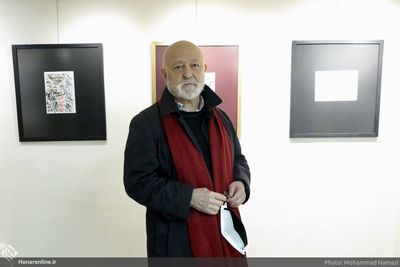In a press release published on Sunday by Golestan Gallery, where a collection of his works in the style of siah mashq is currently being showcased, he said that his emotions were under the influence of the words of Allah over the decade he spent inscribing the entire Holy Quran.
He noted, “Over these past ten years, I totally directed my focus toward writing the dear Quran, nevertheless, I have had the project in mind for forty years and have worked on it.”
“Although I have also carried out some other works over the period, all my behavior, decisions and emotions were totally under the influence of writing the words of Allah.”
82-year-old Ehsai has done the calligraphy of the Holy Quran in 2650 pages, each of which carries five lines. Majid Fadian, a renowned Iranian bookbinder, is preparing the copy of the Holy Quran for publication.
Mohaqqaq script is a style of Islamic calligraphy invented by Ibn al-Bawwab, an Arabic calligrapher and illuminator who lived during the 10th and 11th centuries.
“This style is known as ‘Iranian prose’,” Ehsai said and added, “When they call it by that name, it creates more of a feeling of responsibility to revive it.”
“Since nobody works in this style nowadays, I eagerly decided to revive it but in my own style and contemporary form,” Ehsai stated.
While he has met all the rules for inscribing in the mohaqqaq style, he acknowledged that traces of his personal interest in calligraphic painting can be seen in the inscriptions of the verses.
He said that it is not clear when the Quran will be published, and added, “Mr. Fadaian is doing his best with love just as I did. He has put all his noble energies into practice in working on this book, however, only the original owner of this Holy Book knows everything and is perfect.”
Ehsai is mostly famous for his numerous calligraphic paintings and works created in nastaliq, which have been showcased at exhibitions and auctions across the world.
Following this long period of doing calligraphy of the Holy Quran in mohaqqaq script, the master returned to his favorite style, nastaliq, during the pandemic by creating a collection of works in siah mashq, a style of nastaliq script which is primarily focused on technique and shape rather than meaning.
The collection, which is the result of Ehsai’s doing practice exercises to prepare his hand for nastaliq script, is currently on view at Tehran’s Golestan Gallery in an exhibit that ends on Wednesday.
The home quarantine provided more time for him so he embellished every night of the period by creating pages of siah mashq, which have also been published in a book entitled “Mohammad Ehsai’s Homework”.
The gallery earlier showcased a collection of photos of the world’s museums taken by Ehsai during the late 1960s and early 1970s during his university years.
Source:Tehran Times

